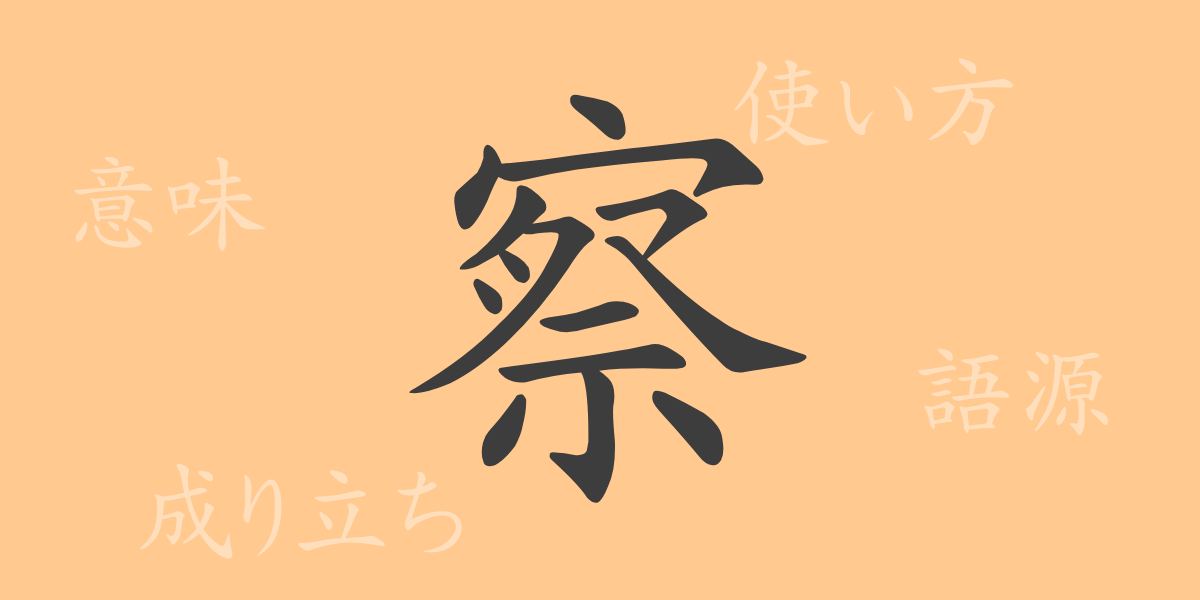The meaning of a single kanji character often holds greater depth than its form suggests. One such frequently used kanji in daily life is “察” (さつ, satsu). This character represents an important concept in social interactions and plays a vital role in our communication. This article explores the origin, meaning, usage, readings, stroke count, and radicals of “察” (さつ, satsu), and introduces idioms and phrases that include this intriguing kanji.
Origin of 察 (さつ, satsu)
The kanji “察” (さつ, satsu) originated in ancient China. Its original form depicted a person peeking inside a room, symbolizing the act of “peeking” or “observing.” Over time, this character evolved to mean “noticing details” and “thoughtfully observing.” Today, “察” (さつ, satsu) is used in various contexts to convey these nuanced meanings.
Meaning and Usage of 察 (さつ, satsu)
The primary meanings of “察” (さつ, satsu) include “to observe and understand,” “to infer,” and “to perceive.” This kanji refers to the ability to closely observe and understand people’s emotions or situations. Usage examples include expressions like “察する” (さっする, sasseru) meaning “to guess or infer,” “察知” (さっち, sacchi) meaning “to detect,” and “同情を察する” (どうじょうをさっする, dōjō wo sasseru) meaning “to sympathize.” In official contexts, it appears in words like “警察” (けいさつ, keisatsu), indicating an organization that understands and responds to situations.
Readings, Stroke Count, and Radicals of 察 (さつ, satsu)
Here are the basic details about the kanji “察” (さつ, satsu):
- Readings: The on’yomi (音読み) reading is “サツ” (さつ, satsu). There are no common kun’yomi (訓読み) readings.
- Stroke count: 14 strokes.
- Radical: The radical is 宀 (うかんむり, ukanmuri), which denotes a roof or building.
Idioms, Phrases, and Proverbs Using 察 (さつ, satsu) and Their Meanings
Several idioms, phrases, and proverbs include the kanji “察” (さつ, satsu). Here are a few examples:
- 洞察力 (どうさつりょく, dōsatsuryoku): The ability to see the essence of things or predict future developments (insight).
- 警察 (けいさつ, keisatsu): A public organization that enforces laws and prevents crime (police).
- 察する (さっする, sasseru): To guess or infer someone’s feelings or the situation (to sense).
- 理解を察する (りかいをさっする, rikai wo sasseru): To understand what someone comprehends (to perceive understanding).
- 風の便りに察する (かぜのたよりにさっする, kaze no tayori ni sasseru): To infer information from rumors or hearsay (to guess from the wind’s news).
Conclusion on 察 (さつ, satsu)
The commonly used kanji “察” (さつ, satsu) is deeply rooted in our daily lives and plays a crucial role in interpersonal and social interactions. Words and idioms containing “察” (さつ, satsu) often denote sensitivity, understanding, and insight. By understanding this kanji, we can aim for richer communication. We hope this article helps deepen your understanding of “察” (さつ, satsu).

























